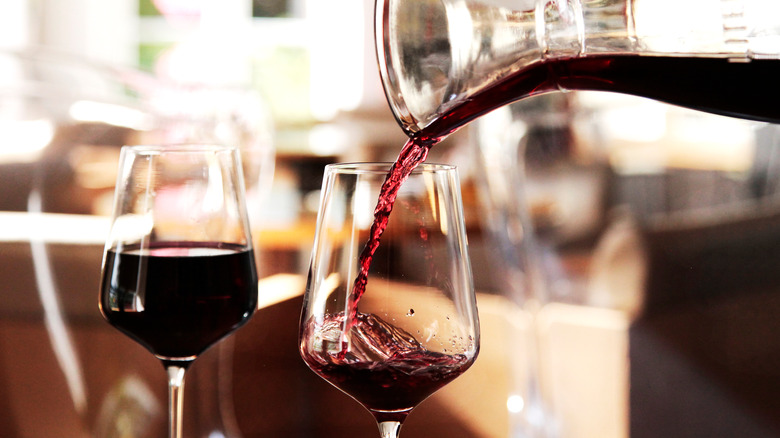Everything You Need To Know About Decanting Wine
If you're someone who has had the concept of oxygen being bad for wine because it causes oxidation drilled into your ideas of how to handle wine, then decanting might seem like a tricky thing to do. While air that is exposed to wine over long periods of time, such as while it is in storage will adversely affect the taste of the wine, decanting wine can improve the flavor and open up the wine (via Master Class). Decanting wine gives its properties — such as its tannins, notes, and flavors — the room it needs to grow.
When you decant wine, it's exposed to more surface area and air than it was in the bottle, which allows it to expand in this way. However, not all wines benefit from decanting. For example, exposing sparkling wines like champagne to more surface area will actually cause it to go flat faster. Otherwise, most wines — both old and young, red and white — can be decanted, though some might not necessarily need the extra exposure. According to Master Class, red wines that are young are the prime candidates for decanting due to its tannins.
Why and when to decant wine
Apart from decanting for air and to let the wine breathe, you may also need to decant for a couple of different kinds of sediment. The first type of sediment has to do with old wine in which natural residue has settled at the bottom of the bottle (via Wine Enthusiast). So, when you pour the wine into a decanter, you can watch the sediment and see it as it begins to gather just below and even up into the neck of the wine bottle. By watching the deposits as you carefully pour the wine into the decanter, you can stop pouring the wine when the sediment gets too close.
The other kind of sediment you might need to decant for is a crumbling cork. If an old cork gives way and fragments fall into the wine bottle, you obviously don't want to pour a glass with them floating around in it. Just like natural sediment in wine, you can follow the same steps to decant the wine while leaving the pieces of cork behind in the bottle.
How to decant wine
If you haven't decanted wine before, then there are a few tips and tricks to make it easier your first time around. Obviously, you will need a decanter, which comes in tons of amazing designs, sizes and price ranges, and a bottle of wine. The first cardinal rule of decanting is that the bottle should ideally come out of storage and stand vertically for 24 hours before it is decanted (via Master Class). This rule does, however, mainly apply to older bottles with sediment at the bottom of the bottle.
After that, all you have to do is open the bottle, and be sure to pour it correctly. That is to say, the wine should be decanted at a 45-degree angle to keep the wine from pouring out too quickly. Remember to watch for residue as you pour. You can always stand the bottle back up and let the sediment resettle to the bottom if you need to.
Once the wine is in the decanter, you can roughly let it sit for about 30 minutes before pouring it into glasses to enjoy (via Wine Enthusiast). Though 30 minutes isn't exactly the magic mark, it is a good starting place. Some wines might be ready to enjoy sooner or later than the 30 minute mark, so you can also try as you go along too.


